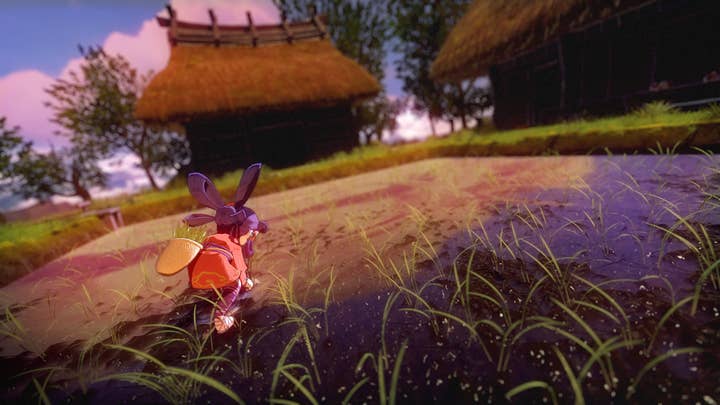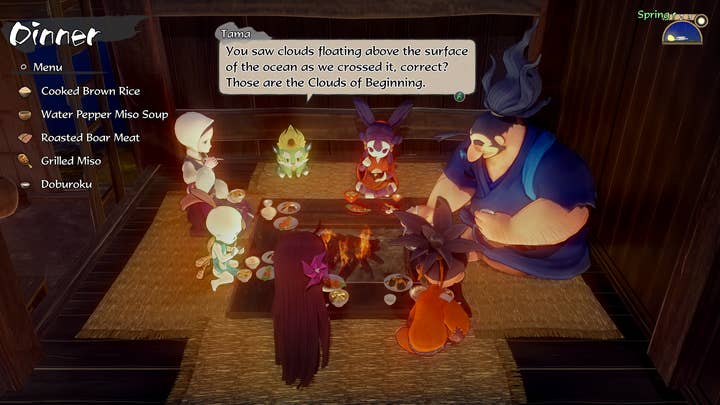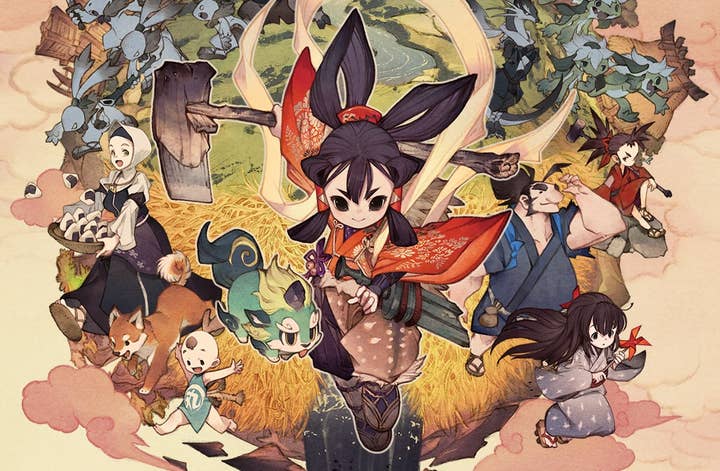The careful cultivation and localization of Sakuna: Of Rice and Ruin
Edelweiss and XSeed discuss the historical Japanese roots of the in-depth rice farming sim, and the challenges of bringing it West
The research developer Edelweiss conducted in order to make Sakuna: Of Rice and Ruin included the following: multiple trips to major libraries in Tokyo and around Japan; hours of reading reference material and papers written by agricultural professors; ordering a rice-growing kit; cultivating rice in their homes.
"As regards rice cultivation, while it has a strong connection to our daily lives, your average Japanese person doesn't actually know that much about it," says Edelweiss director Nal, speaking to GamesIndustry.biz via email. "The same goes for traditional Japanese culture. Researching rice cultivation and our traditional culture really opened our eyes. I found it rewarding to gain a deeper understanding of my everyday surroundings."
Edelweiss is a doujin game development group that started in 2005, and currently consists of only two core members: director Nal, and CG artist Koichi, though Nal says they typically have one to two others working with them at any given time. For Sakuna specifically, more than ten people were working directly on the game toward the end of its development.
"Researching rice cultivation and our traditional culture really opened our eyes"
Nal
Though Edelweiss has released a handful of titles over the years, it's been a long time since its last launch -- Astebreed, in 2013. The studio first began showing off Sakuna in 2016 via screenshots, and it's been showcased at multiple E3s. It's no surprise the team is taking its time, as Sakuna is the studio's most high-profile launch yet, with support from Marvelous publishing arm XSeed for its release in the West, and appearances in multiple Nintendo Directs.
"Edelweiss games have consistently received praise for their exhilarating action elements and criticism for their lack of length, world-building, and story," Nal says. "Hence why we took the time to build up Sakuna's world and setting, which Ryota Murayama further enhanced with his enchanting artwork. For a game with a linear storyline, it compares favorably to games of a similar length. Its overall quality far surpasses that of our previous titles."
Sakuna was originally conceived as a sequel to Edelweiss' previous title, Fairy Bloom Freesia, but evolved into its own property revolving around two primary elements: farming and fighting. Players control Sakuna, the daughter of a war god and a harvest goddess, who is exiled to an island inhabited by demons along with a small group of human refugees from an ongoing war and famine. Together, they establish a rice farm to sustain themselves while Sakuna works to clear the island of demons.

Though the game is clearly half farming simulator, fans of Harvest Moon and Stardew Valley will find something quite different from other genre staples. Instead of cultivating a wide variety of crops, Sakuna focuses entirely on rice growing, honing in on precise details such as water levels, pest control, weeding, seed spacing, and activities such as harvesting, threshing, hulling and seed separating, where nuances in each can impact what kind of rice crop is brought in each year.
"If the game you want to create already exists, then you can't give people a compelling reason to choose your game over another one, so you have to set yourself apart from them," Nal says. "Game companies gravitate toward gameplay elements like growing a wide variety of crops or interacting with a huge cast of characters because they make for powerful sales pitches. On the surface, it seems downright foolish to take the opposite approach of making the player grow only one crop with a never-before-seen level of depth. But it was a worthwhile challenge. Looking back on it now, I think I may have been rebelling somewhat against corporate games."
"If the game you want to create already exists, then you can't give people a compelling reason to choose your game over another one"
Nal
Sakuna's farming elements feed into its combat system, with each year's rice crop giving the titular character stat boosts based on numerous rice growth and yield factors. The power boost is necessary to propel Sakuna through the increasingly difficult sidescrolling platformer levels, which in turn need to be cleared to give Sakuna access to better tools, items, and other necessities for her rice cultivation.
Nal notes that intertwining the two systems in an effective manner was the most challenging aspect of development, saying that "the odds were against us."
"Combining an action platformer with RPG elements -- such as character customization -- and a rice-growing simulator felt like making three games in one, and finding the right balance took a lot of trial and error over a very long period of time. It would make me happy if people came away with the impression that these genres make a perfect match."
Koichi adds: "We struggled to intertwine the various elements and parameters of the action and simulation sections, as well as balance the passage of time in-game. Neglecting any of these issues would cause the player to progress through the action or simulation sections too quickly. The passage of time proved particularly difficult to handle because of how it affects the story. But once we set aside the story for a bit, and focused entirely on solidifying the gameplay cycle between the action and simulation sections, everything else came together much more easily."

Sakuna: Of Rice and Ruin's deep exploration of rice growing is wrapped up in a story, characters and world influenced heavily by Japanese culture, philosophy, and history. Though fictional, it's loosely based on the historical Warring States period, and the characters frequently engage in detailed discussions of Buddhism, philosophy, food, culture, and class divisions. And while much of that (rice growing specifics aside) would be familiar to a Japanese audience, its ideas become more challenging when brought overseas.
Which is where XSeed came in. Though XSeed's primary function is to publish Marvelous games in the West, it also frequently picks up third-party titles of its own, focusing specifically on games that are either from Japan or are heavily influenced by its culture.
"It doesn't tell you what the right answer is, but you get to play around with it. Which is pretty much exactly what rice cultivation used to be"
Kenji Hosoi
XSeed executive vice president Kenji Hosoi and CEO Ken Berry first met Edelweiss at BitSummit when the studio was showing Astebreed, and were impressed with what they saw from a team of only two people. The two companies reconnected sometime later when Edelweiss reached out with Sakuna, noting it was influenced by Vanillaware's Muramasa: The Demon Blade, which Marvelous Entertainment published in Japan.
"We're super excited to be working on a game that's so genuine in some respects," says Berry. "Like the long tradition of cultivating rice in Japan, and people being able to see it reflected much more accurately in a game than ever before."
In their conversation with GamesIndustry.biz, one element of Sakuna that Hosoi is especially fond of is the way it gradually feeds players complex concepts related to rice cultivation by allowing them to discover knowledge at the same time as Sakuna -- who is just as inexperienced as the player. Later in the game, there are systems and skills that can teach players precisely the right way to get their intended outcomes. But for the first few in-game 'years', there is a lot of intentional guesswork.
"The very first time I played it, when I was doing rice cultivating the first time, the game tells you the depth [the water should be]," Hosoi says. "They don't give you a user interface that tells you what's right. 'About up to your ankles is fine,' and you just move your character into the water and you're literally checking her ankle. It doesn't tell you what the right answer is, but you get to play around with it. Which is pretty much exactly what rice cultivation used to be."

For a game like Sakuna that leaned heavily both on complex, realistic systems but also on historical and traditional Japanese culture, good localization was vital. XSeed localization manager John Wheeler took on the task with his team, having recently worked on games in the same genre such as Story of Seasons: Trio of Towns, Rune Factory 4 Special, and the Story of Seasons: Friends of Mineral Town remake (previously Harvest Moon).
"Localization can only make a good game memorable or a great game very memorable, but the core game has to itself be memorable," Wheeler says, when asked about his role in helping Sakuna become successful.
Given that Sakuna was an especially complex title to localize, Wheeler presents a crucial question: "How do you translate something in a way that will make sense in English when it's like a concept that may not make sense even in Japanese?"
"There was a lot of research that had to go into this title and not just researching it, but then how to translate it effectively"
John Wheeler
"Sakuna had a lot of challenges just in terms of researching not just farming techniques or words for traditional tools, but also old words for food," he continues. "There was a lot of research that had to go into this title and not just researching it, but then how to translate it effectively. We had some really incredible translators on this title, who've done such a good job of finding a concise way that conveys the meaning very well without requiring a translator's note."
In a follow-up email after our conversation, Wheeler passes on a story about the challenges of tackling localization nuances when connected with in-depth farming knowledge and history, as told by localizer Elizabeth Bushouse:
"A lot of the diseases [that the rice can get] in particular didn't have much online English info about them," she says. "For example, the search results for 坪枯れ are entirely in Japanese and all they reveal is that it's a disease caused by brown planthoppers. So I had to reverse lookup brown planthoppers in English and discover that they're known for spreading two rice viruses, one of which is called Rice Ragged Stunt Virus, which lines up with the meaning of the Japanese kanji. But there's no indication online that these Japanese and English terms are related at all without someone connecting the dots themselves.

"And also what to call various rudimentary tools used in the rice-refining process, like what's the difference between a こき箸 (kokibashi) and a 千歯こき (senbakoki), which don't have English names and are both types of hand threshers (and the latter of which has a joke about its name at one point in the dialogue).
"Then just generally trying to figure out the right language to use for the rice-growing/refining process -- like is it 'hulling' or 'milling' and is there a difference? Other odds and ends include describing how vinegar is made, whether 稲子 refers to a grasshopper or locust (locusts are just one type of grasshopper, apparently), and if 狢 refers to a badger or a tanuki (raccoon dog), since the term can cause confusion even among Japanese speakers. There was a lot of technical stuff like that."
"At one point Edelweiss had to send a guide to us, and it was pretty involved"
John Wheeler
Wheeler says that while they could rely on images, icons, and descriptions in many cases to make unfamiliar items or mechanics make sense, another problem arose when it came to the character dialogue. The refugees Sakuna spends the game with include an ex-samurai, two young children from different rural communities, a toddler, and a missionary woman from a different fictional country entirely (implied to be somewhere in the equivalent of Eastern Europe). The group not only speaks with different accents based on their origins, but also with different philosophies, customs, and histories that hint at real-world equivalents.
"One of the big challenges with going from Japanese to English is dialect," Wheeler says. "Kinta, the young boy, and Yui, the young girl, have this really intense dialect in Japanese -- it's a very rural dialect. At one point Edelweiss had to send a guide to us, like this is what it means in standard Japanese when they say this, and it was pretty involved.
"How do you approach that kind of very rural dialect, particularly when spoken by children? One of the ways that our translator and editor approached it is to make them very, not just casual, but also have them use a lot of contracted words, and use some slang. So you kind of get it across, almost like tone, or like speaking style, I think is the way that it's typically approached."

One major factor in Sakuna's localization that was different from how Wheeler typically works was Edelweiss' involvement. He says the developers worked very closely with XSeed, providing assistance and feedback to ensure their intentions were understood, and even gave the XSeed team access to a build of the game to work in directly -- something Wheeler says is very rare in localization.
"Typically there's a barrier between the developers and the localization team," he says. "And we send the text and they send us a build, and we check text in the build. But Edelweiss gave us access to the exact environment that they were working in, so it gave us more responsibility to check things ourselves. With a different project, you can really lose a whole week or two weeks sending new text, waiting for a build, and checking into the build. It's hard to describe how revolutionary it is to be able to see how something's going to look on screen within a minute."
Sakuna: Of Rice and Ruin represents a major milestone for indie developer Edelweiss, bringing its name and IP to a much wider audience than it previously reached. And for XSeed, Sakuna may also represent a turning point, with Berry suggesting it is an example of a new direction for the publisher.
"We do love licensing third-party titles," he says. "But I don't know if that is something that will be available quite as much in the future, as people look more towards either self-publishing, digitally or internationally. So many people are already moving in that direction now where they're getting [their games] translated into English themselves, or paying for publishing before even talking to someone like us who would localize it into English for them.
"So I think, maybe with that part of the business shrinking, we would focus more on the indie side. Sakuna is a great example. We would love to find more talented teams like Edelweiss and help them find their way to getting a game out here."

